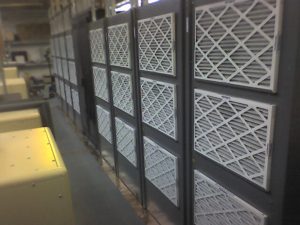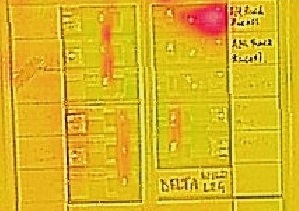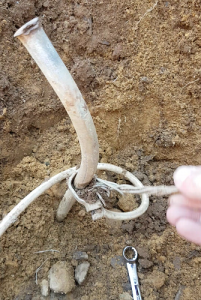
Hey folks, happy summer (or winter, for those south of the equator)! It’s been a long hot summer here in the northeast corner of North America and busy as usual. Summer convention season is starting to draw to a close and one of the things I saw this year was a presentation by Paul Tinkle at the Arkansas Broadcasters Association. Paul is the President of Thunderbolt Broadcasting in Martin, Tennessee and an all-round good person. He’s the sort of owner an engineer dreams of working for, one who understands the value of good engineering and, while careful about the budget, gets the need for preventative maintenance.
Folks who read our last Waves will recall that I did a 50 Tips for 50 Years – a recap of tip highlights in honour of our 50th anniversary. Well Paul’s presentation The Manager’s Engineering Notebook is 48 tips for managers to help them understand engineering and to be of assistance when needed. It also helps to highlight the value of engineering – and it provides some good overall tips that are of use to engineers and management alike. With that in mind, I asked Paul if it would be okay to reprint his tips here (we’ll also feature some of the highlights in a joint webinar in October) – thanks so much for this, Paul!
So, here goes…
Tip 1 Purchase a label maker and label all equipment by the name you commonly refer to it. Label everything in your service rack. Label the front and back of each piece of equipment and where plugs and wires are inserted. (note from Jeff – also, print the serial number and stick it to the front of the unit, where it’s easier to access, for when you need to call support!).
 Tip 2 Label STLs, Martis and other RF equipment, including call signs and date each piece of equipment went into service. Do the same for computers, with their install date. Label the front of each satellite receiver with the name of the program that is associated with that receiver. Include the serial number on the front of the receiver.
Tip 2 Label STLs, Martis and other RF equipment, including call signs and date each piece of equipment went into service. Do the same for computers, with their install date. Label the front of each satellite receiver with the name of the program that is associated with that receiver. Include the serial number on the front of the receiver.
Tip 3 Label your station calls on all remote gear, including headphones, power cords and of course phone and RF equipment used away from the station. This includes all sports gear. Take a photo of your remote gear with your smart phone or camera. Label the year every piece of equipment was installed or acquired.
Tip 4 Learn how to read transmitter meters and take readings occasionally to stay fresh – this also makes it easier for you to show talent what’s expected.
Tip 5 Affirm all EAS equipment has written instructions on how to perform an EAS test. Keep instructions in the control room. Insure all on-air announcers and office staff comply with the requirements.
Tip 6 For AM stations, inspect your ATU (Antenna Tuning Unit) inside the “dog house” located at the tower base to insure no snakes, birds or bad things have happened. Do this even in the winter. Inspect the ground to see if anything has fallen from the tower while there.

Tip 7 Insure your ASRN (antenna structure registration number) is clearly displayed at the tower site and that the fence is structurally sound, with the gate to your tower locked.
Tip 8 Inspect your guy wires for damaged insulators. Inspect tower anchors for possible damage due to mowing or lightning. Keep your tower site mowed and neat. Inspectors like that! (note from Jeff, engineers do too!!!)

Tip 9 Keep a spare set of keys to everything you own with you, or in your vehicle. You WILL need them some day.
Tip 10 Keep a journal or notebook (not a legal pad) at the remote tower site and mandate anyone who enters the building to log readings. This will include time in and out, as well as who was on site. Keep your “vital” records (license) at the tower site inside plastic sheets in a binder. This includes STL (license) path information. Plastic sheets are harder for mice to chew through. These vital documents will likely survive in the event the book gets wet. (note from Jeff – Tupperware™ containers are also great for storing printed material – log books, licenses, equipment manuals, etc.)
Tip 11 At the tower site or transmitter location, confirm you have a spare tube/parts kit for the transmitter and other vital equipment. Ask your engineer what s/he could NOT do without if the transmitter or vital piece of equipment died.
Tip 12 Also, at the tower site, maintain basic tools for your engineer or yourself, along with some drinking water, paper towels, hand sanitizer, a cot for resting and toilet paper (note from Jeff: if you store these things in a 5 gallon plastic pail, it keeps the critters out of them – not the cot, obviously! Lined with a kitchen garbage bag, the pail can also be used as an emergency lavatory if need be. There are plenty of sites about putting together an emergency kit – one example can be found here.)

 Tip 13 Change or clean all filters on transmitters and your HVAC units at least monthly. Dust is a killer of many transmitters and other equipment. If you have a window AC unit at a remote tower site, cover the intake vents with cheesecloth (buy it at the big box or grocery store). Duct tape works fine to tape it. You’ll be amazed at how the cloth keeps dust from getting sucked into your unit!
Tip 13 Change or clean all filters on transmitters and your HVAC units at least monthly. Dust is a killer of many transmitters and other equipment. If you have a window AC unit at a remote tower site, cover the intake vents with cheesecloth (buy it at the big box or grocery store). Duct tape works fine to tape it. You’ll be amazed at how the cloth keeps dust from getting sucked into your unit!
 Tip 14 Insure all on air computer filters are cleaned monthly.
Tip 14 Insure all on air computer filters are cleaned monthly.
Tip 15 Keep a Shop Vac™ or industrial vacuum cleaner at the transmitter site to help keep your building and equipment clean. Transmitters hate dust!
 Tip 16 Have several flashlights and batteries in your building and one in each control room. Check the batteries in your smoke detectors, too.
Tip 16 Have several flashlights and batteries in your building and one in each control room. Check the batteries in your smoke detectors, too.
Tip 17 If you have a generator, check it monthly, but exercise it weekly. Insure you have extra oil and coolant on hand and check the fuel and oil level and examine the battery. Log it in your journal and write down the hours exercised.

Tip 18 Personally inspect your towers at night to confirm all bulbs are burning. Inspect the tower in daylight of course, to confirm it will pass FCC paint regulations and if it’s a strobe, be sure it’s strobing!
Tip 19 Document that you have notified officials when a bulb goes out. Keep the phone number and the ASRN accessible, preferably in your phone and get a confirmation. If you have air ambulance service operating around your community, notify them when a bulb goes out. You don’t want any pilot running into your tower or guy wires. They will thank you when you call – in many cases, pilots use your tower as a marker in the sky!
Tip 20 For AM stations, confirm your annual NRSC Occupied Bandwidth Measurement and Frequency Test has been done within the past 14 months and have it ready for the FCC upon request. Note: it does NOT go in the Public File (Online file) but must be available for inspection.
 Tip 21 Visually inspect your STL, Marti and other auxiliary antennas that are on your service or other tower and insure wind has not damaged or loosened elements, coax, etc. after storms.
Tip 21 Visually inspect your STL, Marti and other auxiliary antennas that are on your service or other tower and insure wind has not damaged or loosened elements, coax, etc. after storms.
Tip 22 Walk around the back of your radio station building and see if anything is out of place, such as loose cables, vandalism or strange visitors, including cats, rats, snakes, deer, bear or groundhogs that may have paid your company a visit!
Tip 23 Keep spare tools in your vehicle, including an air pump and of course duct tape.
Tip 24 Keep wasp/hornet repellent available at the tower site. Have a first aid kit, or at least Band-Aids. You’ll need them some time!
 Tip 25 Instruct full and part timers where vital controls are located, such as the electrical breaker box. Label the breakers clearly, should they need to be turned off. Feel your breaker box. If a breaker is hot to the touch, call the electrician and your engineer NOW! Post the number of your electrician on the outside of the breaker box.
Tip 25 Instruct full and part timers where vital controls are located, such as the electrical breaker box. Label the breakers clearly, should they need to be turned off. Feel your breaker box. If a breaker is hot to the touch, call the electrician and your engineer NOW! Post the number of your electrician on the outside of the breaker box.
Tip 26 Insure transmitter information from the factory (or broadcast consultant) such as your TPO (transmitter power output) is located at the tower site and is in a plastic sheet in a binder. This will be helpful to quickly find for an FCC Inspector. Good idea to put the TPO on the transmitter.
Tip 27 Place a copy of all facility licenses in a plastic sleeve and put them in binders at the transmitter site and at the radio station.
Tip 28 Locate a manual for every piece of equipment and insure you have it at the site or station for easy engineering repair access. Create a library at the radio station for all manuals.
Tip 29 Have your engineer plan for the year and determine what you think your plan (new equipment) may cost.
Tip 30 Communicate with your engineer. Determine what equipment needs replacing now and in the future.
Tip 31 Instruct full and part timers how to turn on and turn off vital equipment.
 Tip 32 Use combination locks on all gates and tower entrances (no need to search for keys). Cut a piece of an old tire inner tube and use a kitchen potato chip clip to cover the lock in bad weather, especially snow and ice.
Tip 32 Use combination locks on all gates and tower entrances (no need to search for keys). Cut a piece of an old tire inner tube and use a kitchen potato chip clip to cover the lock in bad weather, especially snow and ice.
Tip 33 Keep records on your equipment. Date of installation, date of service, etc.
Tip 34 Take pictures of all of your equipment. Have what the insurance company needs, including serial number, make and model of all equipment. (note from Jeff, it can also be useful to have a replacement cost – even if only updated every 3-5 years… this also comes in handy when working with your accountants to determine the amount of insurance required).
Tip 35 When shipping a piece of equipment off for repair, be sure and tape your business card to the equipment or use a label maker placing your company’s name somewhere on the equipment!
 Tip 36 Ask your engineer what they need to do their job better. Sometimes it’s just an extra roll of tape. Take your engineer to lunch, buy them some gas and thank them for taking care of the station!
Tip 36 Ask your engineer what they need to do their job better. Sometimes it’s just an extra roll of tape. Take your engineer to lunch, buy them some gas and thank them for taking care of the station!
Tip 37 When installing new wiring or cable on a piece of equipment, label it on both ends, so you can easily identify its use!
Tip 38 Have your weekend part timer/night timer run an EAS test using the instructions from the book you have in your control room. And, of course, document it in your EAS book.
 Tip 39 Examine your grounding. Lightning loves radio equipment. Have your electrician perform a “grounding” inspection. Contact your electric company for a good inspector.
Tip 39 Examine your grounding. Lightning loves radio equipment. Have your electrician perform a “grounding” inspection. Contact your electric company for a good inspector.
Tip 40 If you own a generator, when you’re on site to exercise it, open the front panel and any doors and look for mice.
Tip 41 When shipping equipment in for repair, another idea is to put a station bumper sticker on the equipment. They’ll remember that at the factory, when they’re trying to locate it!
Tip 42 If you have a remote vehicle, drive it yourself periodically, inspect it for damage and service record. Keep records on your remote vehicle. Check tires and drive to see how it performs. It may pull to one side, make a noise, or you may find it trashy. If connected to remote gear, make sure you have tested it personally.
Tip 43 Inventory play by play equipment. Learn what needs to be replaced or repaired and is being treated professionally. Put headphones in gallon or two gallon plastic freezer bags.
 Tip 44 If there’s a problem at the transmitter site, tell the engineer you want to come watch or hold the flashlight. It’s times like these that some engineers like company and maybe an extra hand. (note from Jeff, there’s also a huge safety benefit to having somebody else at the site, vs. working alone).
Tip 44 If there’s a problem at the transmitter site, tell the engineer you want to come watch or hold the flashlight. It’s times like these that some engineers like company and maybe an extra hand. (note from Jeff, there’s also a huge safety benefit to having somebody else at the site, vs. working alone).
Tip 45 Find out where the FCC rules are kept in the radio station and make every one aware of them.
Tip 46 Participate in your state ABIP (Alternative Broadcast Inspection Program). This is great insurance and helps your engineer keep your equipment running smoothly (with respect to tolerance) and keeps your staff aware of the EAS rules.
Tip 47 When in doubt about the FCC Rules and Regulations, contact your FCC attorney. Spend the money to keep your station legal! It’s better to spend money on engineering than to wait and spend money at the FCC rectifying a Notice of Apparent Liability!
Tip 48 Get to know more than your one engineer. Network at your state association of broadcasters convention. Ask your engineer, “who are the people you would want me to call if you were in the hospital?”
So, there you have it folks, 48 tips for the owner/manager, from the perspective of one who works with engineers on a regular basis! Thanks again, Paul, for understanding that we’re all on the same team when it comes to making great radio and to everybody, be safe and happy engineering!
Jeff
Jeff Welton, has worked with Nautel for 25+ years. He is currently the Nautel Sales Manager for U.S. Central Region but previously he spent 16.5 years as a Nautel Customer Service Technician.
Submissions for this Tips ‘n Tricks column are encouraged and if published you’ll receive a Nautel T-shirt. Submissions should be typed and emailed, with high resolution photos, to [email protected] using the subject line Tips ‘n Tricks.

